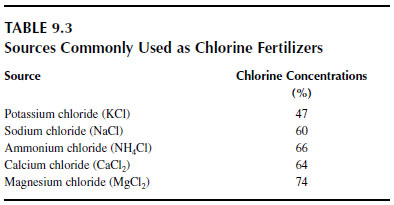Kinds of Chlorine
Chlorine is added to soil from a wide variety of sources that include chloride from rainwater, irrigation waters, animal manures, plant residues, fertilizers, and some crop protection chemicals. The amount of chloride deposited annually from the atmosphere varies from 18 to 36 kg-1 ha-1 year-1 for continental areas to more than 100 kg-1 ha-1 year-1 for coastal areas (4). Most of the chloride applied as animal manures or plant residues is soluble and readily available for crop uptake. Because most of the chloride in animal manure is probably present in the liquid fraction, manure management and handling may influence the concentration of chloride.Potassium chloride is the most widely applied chloride fertilizer. Although KCl is usually intended as a potassium fertilizer, it in effect supplies 0.9 kg of chloride for each kg of potassium. Other chloride fertilizers include NaCl, CaCl2, MgCl2, and NH4Cl (Table 9.3). All these salts are soluble and readily available to supply chloride for plant uptake. Organic agriculture, which discourages the use of KCl and most salt-based fertilizers, obtains chloride primarily from manure and other natural sources.
 |




